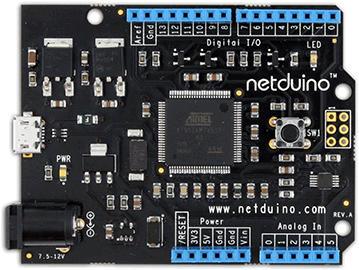From the last post on Exploring the Netduino, we learned that the Netduino is a lot like the Arduino Uno in physical and electrical aspects, but the Netduino has a few advantages in its court: ~3 times the processing power, 32-bit ARM7, and nearly 30x the RAM. But it was also noted that the Netduino runs a slimmed down version of the .NET Micro Framework (NETMF) which naturally will require more overhead than the native binaries that are compiled down tightly for the Arduino Uno’s ATmega328 8-bit AVR processor.
If you have a Netduino (or are thinking of getting one) and have not yet tried out (or looked at) the Netduino “Getting Starting” guide, I recommend reading it. It walks the reader through setting up their development environment and then writing a simple “Hello, World” type program which gets the little blue light on the board to blink. Unfortunately, this introduction is quite limited and might leave you saying “Well, blinking a blue light was fun, but what next?” Glad you asked!
